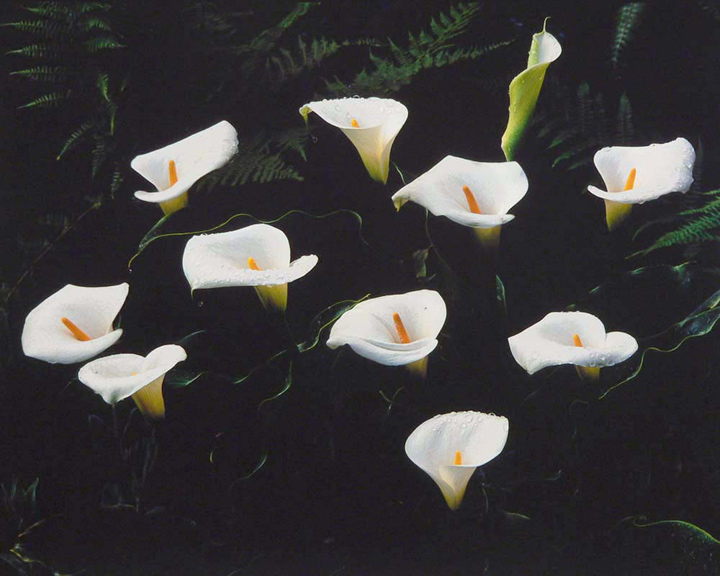Eleven Callas and Raindrops
Oregon

20×24″ prints are $1,500
30×40″ prints are $3,000
I’ve always loved Calla Lilies. When I was a teenager I sent away to a seed company in the Himalayas. After a long wait I received a packet with seeds for five different types of exotic arums (callas are part of the arum family). I raised these plants from seeds and in a couple of years they thrived and bloomed. Really cool. Fast forward to 2002 when I was able to purchase a large box of white calla rhizomes from a wholesale grower in Oregon.
I planted the callas in areas on our home property which have natural springs that keep the soil moist all the time, just perfect for callas. I also planted some at our studio right next to a pond on the property. The callas grew and thrived. I photographed one group with my Hasselblad camera in 2003, “White Callas at Dawn.”
This group of callas is close to our house and can be seen from the bay window of the breakfast nook. I had been observing them for several days and brought all my 8×10 equipment home with the hope that the plants, lighting and weather elements would come together for a photograph.
On the morning of May 20, 2007 the sky was overcast with scattered light showers, the callas were at their peak and I was outside, eager to begin. I set up my Sachtler tripod, composed and focused my 240mm Apo-Sironar-S lens. The image looked good but the rain started drizzling. I pulled the camera off the tripod, covering it with my coat and went back inside. Twenty minutes later I was back at it but the rain came back again. Another wait, then another try.
One of the great things about my tripod is that it comes with a fail safe quick-lock mechanism. You attach a machined metal plate to the base of the camera, then when you put it on the tripod it snaps and solidly locks into place. So each time I came back I didn’t have to compose and refocus the image.
I took light meter readings and knew that the scene would be recorded as you see here because the white calla blossoms were much brighter than the surrounding foliage. I had to increase the exposure by one f/stop due to the bellows extension factor and exposed my Provia film at f/64 for 1.5 seconds.
When you use a lens for closeup photography the effective focal length is longer (the actual distance from the film to the lens) and therefore the effective f/stop is smaller. f/stops are calculated by dividing focal length of the lens by the size of the aperture. Another result of this is that the perspective of the lens is like a longer focal length lens. In this case, the photograph made with my 240mm wide angle lens looks like a photograph made with a 360mm normal lens.
The Cibachrome print is how I visualized it when I made the photograph. The white callas with scattered raindrops float over a mysterious dark sea of foliage. On 30×40” prints the callas are larger than life, with perfect sharpness and luminosity. The blossoms seem to glow with an inextinguishable inner light.